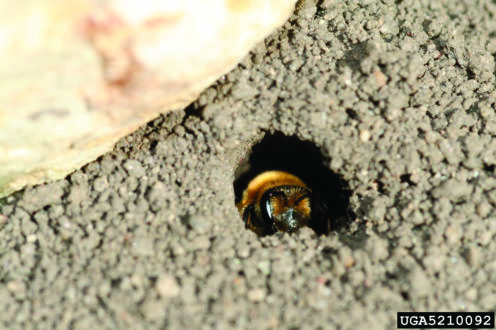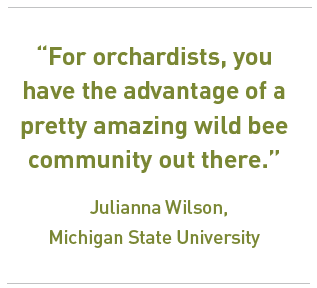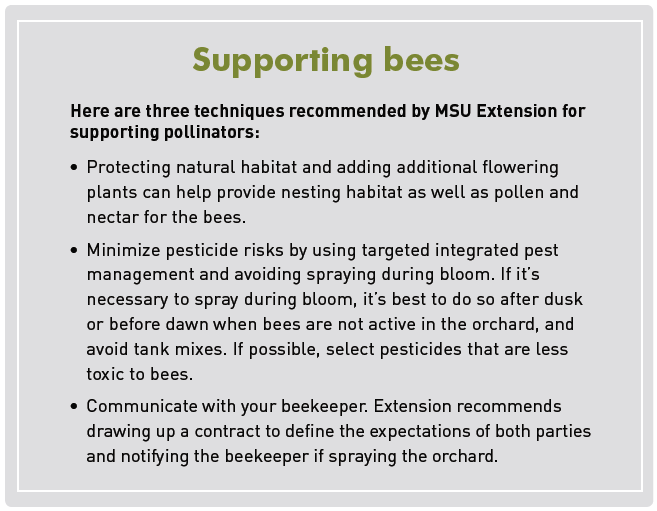

Mar 29, 2018Fostering wild bees for orchard pollination
Be nice to wild bees: They live near your farm and go to work without being asked.
Native pollinators are a force for good in Michigan orchards, and although they don’t draw paychecks, there is much orchard growers can do to encourage their work.
Julianna Wilson, a tree fruit integrator in Michigan State University (MSU) Department of Entomology, spoke about using wild bees to increase fruit set at the Great Lakes Fruit, Vegetable & Farm Market EXPO in Grand Rapids. Her advice was based on a study of pollinators at Michigan orchards. Based on her work, 99 different species of bees visit Michigan orchards.
While non-native honeybees are the most numerous pollinators of Michigan apples, they are just one of the 99 species. Even growers who rent or keep honeybees benefit from wild bees: MSU Extension advises that orchards visited by many different kinds of bees have higher fruit set than those visited by one kind of bee. And while most bees don’t fly below 55° F there are some native spring bees that will fly at those temperatures because they’re better adapted for the cooler weather, Wilson said.


Ground-nesting bees – miner bees, longhorn bees and sweat bees – are the unsung heroes of pollination from the wild pollinator group, Wilson said. The most common wild bees found in Michigan orchards are mining bees (Andrena spp.). There are more than 10 varieties of mining bees, which are efficient apple pollinators.
“They are essentially solitary bees for the most part,” Wilson said. “They’re nesting in the soil, in the ground, and by solitary, I mean, they’re not cooperating in their nesting. And they’re not aggressive. They’re mainly collecting pollen and so they’re really good at collecting pollen.”
She advocates for bee-friendly plantings adjacent to orchards – both honeybees and wild bees benefit from having a variety of pollen available during a longer period of time. Miner bees in particular favor woody plants, such as sumac, that bloom right before or right after apple bloom. Other solitary bees have similar preferences.
“What you can provide them with is flowering resources on either side of the orchard bloom: early-blooming things like willows and other rosacea plants that are going to be related to cherries and apples,” Wilson said. “But also, actually, dandelions provide resources for Andrena, which is the genus name of these digger bees, and also provide extra resources for honeybees – they can’t just survive on orchard pollen alone, they need other resources to be healthy.”
While woody flowering plants are helpful, so are prairie-type plantings of wildflowers. Of the 99 bee varieties found in orchards, 24 were found in common with bees visiting a nearby pasture.
The second most common type of wild bees found in Michigan orchards is sweat bees (Halictus and Lasioglossum spp.), which nest in the ground and can be solitary or “semi-social” depending on the exact species. A field or other habitat that blooms throughout the growing season can help increase their numbers in the vicinity.
Mason bees (Osmia spp.), also solitary, nest above ground in natural and man-made cavities. Not as common in Michigan orchards as other wild bee species, they can be encouraged by setting out nesting materials, such as hollow reeds or cardboard tubes.
Bumblebees (Bombus spp.) are social bees native to North America that form colonies. Each spring, a queen emerges from overwintering and must raise a new colony of workers. Queen bumblebees can be found visiting apple orchards during bloom but are not typically found in large numbers. Flowering plants that bloom later in the season can help increase queen production for the following season.
“Essentially, that is how you can help to build up your wild populations, by either conserving or cultivating flowering resources around the orchard,” Wilson said. 

– Stephen Kloosterman, Assistant Editor
Above: A ground-nesting bee (Andrena spp.) sits in its home. Photo: Whitney Cranshaw, Colorado State University, Bugwood.org














